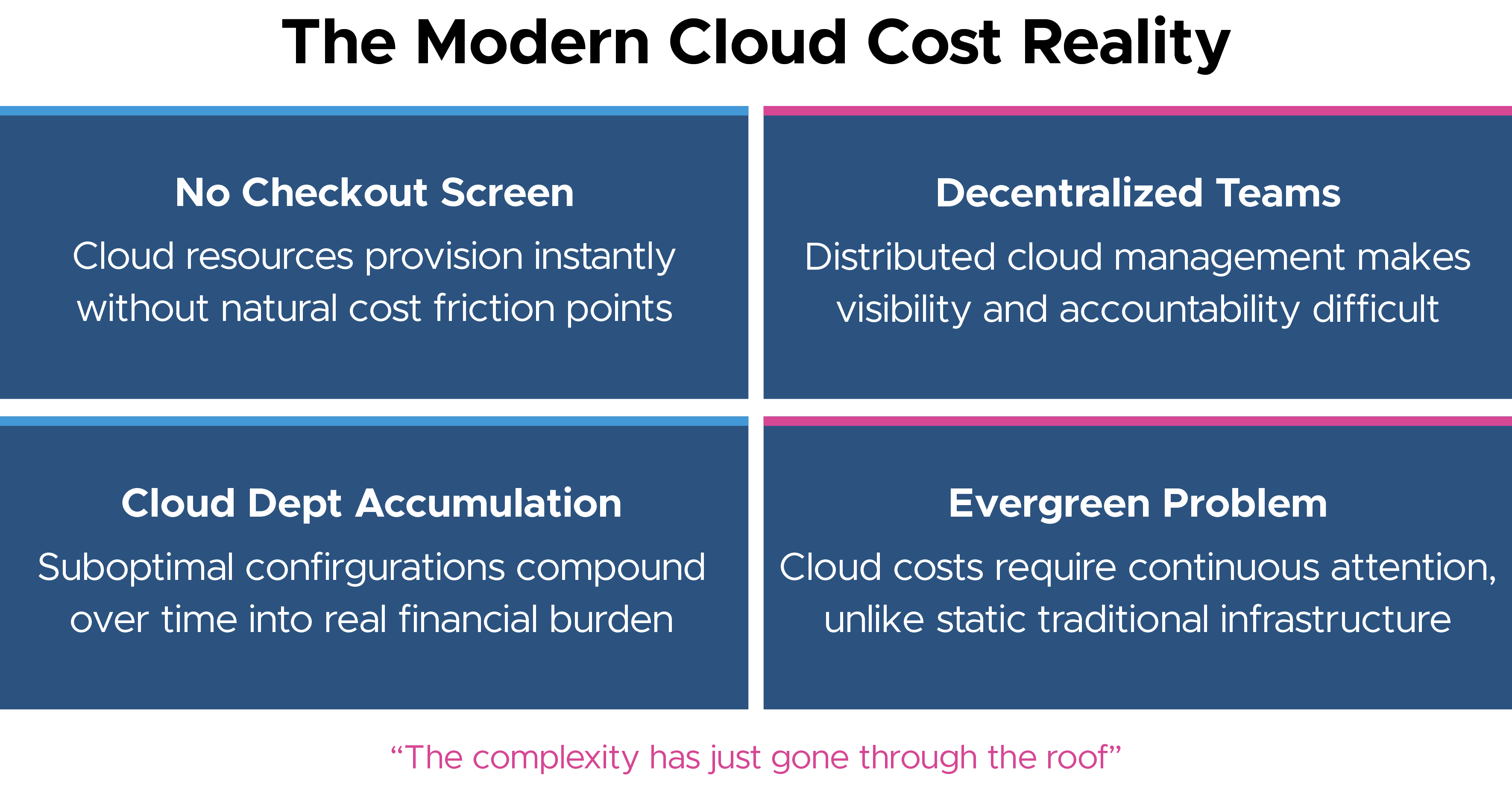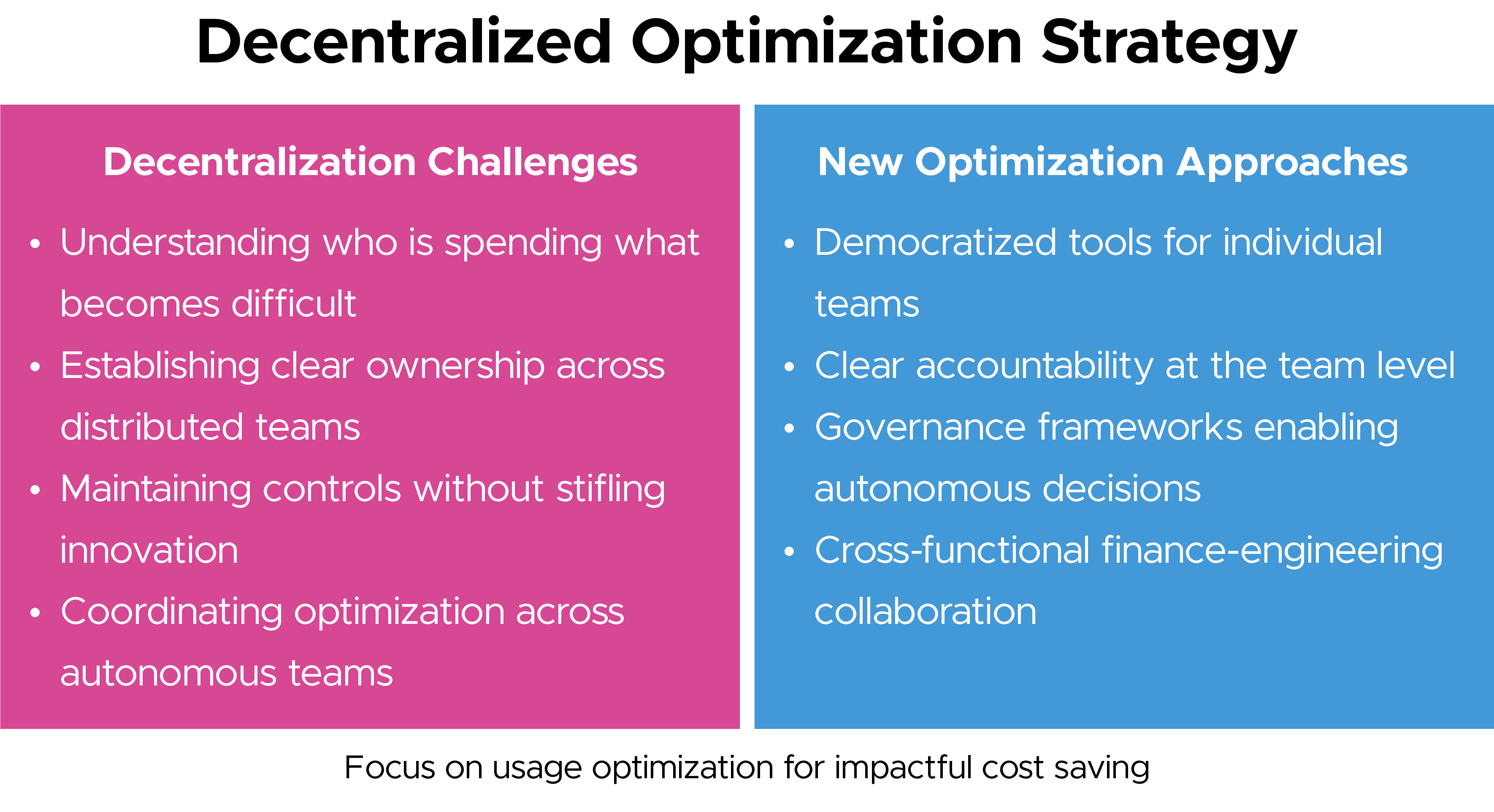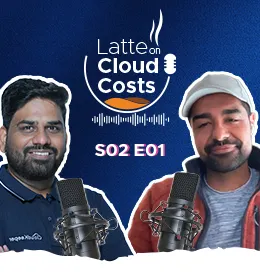Season 2 of "Latte on Cloud Costs" kicks off with a compelling conversation between host Praneet Chandra and Hassan Hosseini, Co-founder and CEO, Infrasoft, diving deep into the evolving landscape of cloud cost optimization. This episode explores how the cloud cost management field has transformed, the emerging challenges organizations face, and the innovative approaches needed to tackle modern cloud financial operations.
The Evergreen Nature of Cloud Cost Challenges
Hassan opens the discussion by establishing a fundamental truth: cloud cost is an evergreen problem that requires continuous attention. Unlike traditional infrastructure costs that were relatively predictable and static, cloud costs demand ongoing vigilance and active management. This reality sets the stage for understanding why cloud cost optimization has become such a critical discipline for modern organizations.
The Complexity Explosion
One of the most striking insights from the conversation is Hassan's observation that "The complexity has just gone through the roof." This statement encapsulates a major shift in the cloud cost optimization landscape. Where early cloud adopters dealt with relatively straightforward pricing models, today's organizations navigate an intricate web of services, pricing tiers, and optimization options.
This complexity stems from several factors:
- The proliferation of cloud services and features
- Increasingly sophisticated pricing models
- Multiple deployment options and configurations
- The rise of multi-cloud and hybrid environments
For CTOs and engineering leaders, this complexity presents both opportunities and challenges. While more options can lead to better cloud optimization, they also require deeper expertise and more sophisticated management approaches.
The Decentralization Challenge
A significant portion of the discussion focuses on how decentralization in cloud management creates unique challenges for cloud cost optimization. As organizations move away from centralized IT models toward distributed, team-based cloud management, traditional cost control mechanisms become less effective.
Hassan explores how this shift impacts:
- Visibility: Understanding who is spending what becomes more difficult
- Accountability: Establishing clear ownership of cloud costs across distributed teams
- Governance: Maintaining cost controls without stifling innovation
- Optimization: Coordinating cost-reduction efforts across multiple autonomous teams
This decentralized reality requires new approaches to cloud cost management that balance autonomy with fiscal responsibility.
Shifting Left: Integrating Cost Awareness Early
One of the key concepts discussed is the importance of shifting left in FinOps practices. This means integrating cost awareness earlier in the development process, rather than treating it as an afterthought or periodic review activity.
The shift-left approach involves:
- Design-time considerations: Evaluating cost implications during architecture and design phases
- Development integration: Building cost awareness into development workflows and tools
- Early feedback loops: Providing developers with real-time cost information
- Proactive optimization: Addressing cost issues before they compound in production
This proactive approach helps organizations avoid the accumulation of what Hassan refers to as "cloud debt" - the technical and financial burden that builds up when cost considerations are deferred.

The Cloud Debt Crisis
Hassan introduces the critical concept of cloud debt, stating that "Cloud debt is a real issue we need to address." This represents the accumulation of suboptimal cloud configurations, unused resources, and inefficient architectures that compound over time.
Unlike technical debt, which primarily affects development velocity, cloud debt has direct financial implications. It manifests as:
- Unused or underutilized resources
- Inefficient service configurations
- Legacy architectures that don't leverage modern cost optimization features
- Lack of proper tagging and resource management
Organizations must address cloud debt proactively, as it becomes increasingly expensive and difficult to resolve over time.
The Invisible Checkout Problem
A particularly insightful observation from Hassan is that "There's no checkout screen for the cloud." This simple statement captures a fundamental challenge in cloud cost management: the absence of natural friction points that would typically prompt cost consideration.
Unlike traditional purchasing processes where costs are visible and require explicit approval, cloud resources can be provisioned instantly without immediate cost visibility. This creates an environment where costs can spiral without obvious warning signs, making proactive monitoring and governance essential.

Generative AI: Promise and Peril
The conversation explores the potential of generative AI to transform cloud cost management while acknowledging the associated risks. Hassan discusses how AI can assist with:
- Pattern recognition: Identifying cost optimization opportunities across complex environments
- Predictive analytics: Forecasting future costs based on usage patterns
- Automated optimization: Implementing cost-reduction measures without human intervention
- Anomaly detection: Identifying unusual spending patterns that might indicate issues
However, the integration of AI also introduces new challenges and risks that organizations must carefully manage.
Understanding the Cloud Cost Formula
Hassan emphasizes the importance of understanding the fundamental formula of cloud costs for effective management. This involves recognizing that cloud costs are driven by:
- Resource provisioning: The infrastructure and services allocated
- Usage patterns: How those resources are actually utilized
- Pricing models: The specific cost structures and optimization options available
- Operational efficiency: How well resources are managed and optimized
This formula-based approach helps organizations identify the most impactful optimization opportunities.
Prioritizing Usage Optimization
A key takeaway from the discussion is the importance of prioritizing usage optimization for impactful cost savings. Rather than focusing solely on procurement or contract negotiations, Hassan advocates for examining how resources are actually used and optimizing consumption patterns.
This approach involves:
- Analyzing actual usage patterns versus provisioned capacity
- Identifying opportunities for right-sizing and resource optimization
- Implementing automated scaling and scheduling policies
- Optimizing application architectures for cost efficiency
Strategies for Decentralized Optimization
Given the decentralized nature of modern cloud environments, Hassan discusses the need for decentralized optimization strategies. These approaches recognize that effective cost optimization cannot be managed solely from a central team but must be embedded throughout the organization.
Key elements of decentralized optimization include:
- Democratized tools: Providing cost visibility and optimization tools to individual teams
- Clear accountability: Establishing ownership and responsibility for costs at the team level
- Governance frameworks: Creating guidelines and policies that enable autonomous decision-making
- Cross-functional collaboration: Facilitating cooperation between finance and engineering teams

The Critical Role of Collaboration
Throughout the discussion, the importance of collaboration between finance and engineering teams emerges as a key theme. Hassan emphasizes that successful cloud cost management requires breaking down traditional silos and creating shared understanding between these traditionally separate functions.
This collaboration involves:
- Shared metrics: Establishing common KPIs that both teams can understand and act upon
- Regular communication: Creating forums for ongoing dialogue about cost optimization
- Aligned incentives: Ensuring that both teams are motivated to achieve cost efficiency
- Knowledge sharing: Facilitating the exchange of domain expertise between finance and engineering
Practical Implications for Leaders
For CTOs and engineering leaders, this episode provides several actionable insights:
- Embrace complexity: Rather than fighting the increasing complexity of cloud costs, develop systems and processes to manage it effectively
- Invest in shift-left practices: Integrate cost awareness into development processes from the earliest stages
- Address cloud debt proactively: Don't let suboptimal configurations accumulate; address them systematically
- Build decentralized capabilities: Enable teams to manage their own costs rather than relying solely on central oversight
- Foster collaboration: Break down silos between finance and engineering to create shared ownership of cost optimization
Looking Forward
As Season 2 of "Latte on Cloud Costs" begins, this conversation with Hassan Hosseini sets the stage for exploring the evolving landscape of cloud cost optimization. The themes of complexity, decentralization, and collaboration will likely continue to shape how organizations approach cloud financial management.
The episode underscores that cloud cost optimization is not a static discipline but one that must continuously evolve to meet new challenges and opportunities. As cloud environments become more sophisticated and distributed, the approaches to managing their costs must evolve accordingly.
This episode of "Latte on Cloud Costs" provides valuable insights for any organization looking to navigate the complex world of cloud cost optimization. Stay tuned for more episodes as Season 2 continues to explore the cutting edge of FinOps practices and cloud financial management.

